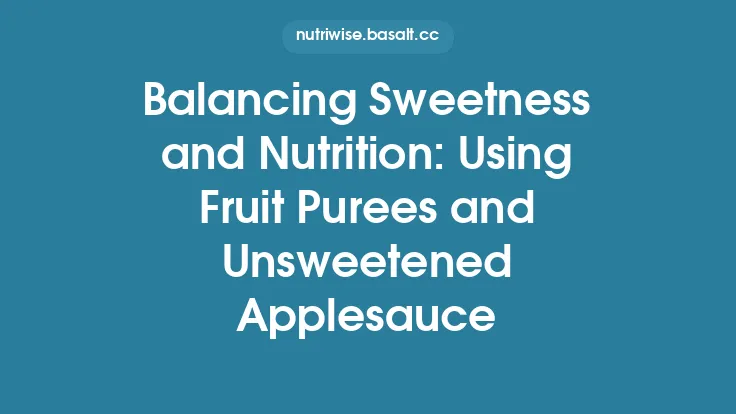Fermentation has long been celebrated for its ability to transform simple ingredients into nutrient‑dense, probiotic‑rich foods. Yet, the traditional reliance on generous amounts of salt—often 2 % to 3 % by weight—can be a stumbling block for those watching sodium intake for cardiovascular health. Fortunately, modern research and practical kitchen experience have revealed a suite of low‑salt fermentation methods that preserve the tangy, complex flavors we love while still delivering robust probiotic benefits. This article explores the science behind salt’s role, strategies to reduce sodium without compromising safety or taste, and practical techniques for a wide range of vegetables, fruits, and legumes.
Understanding Salt’s Dual Role in Fermentation
Microbial Control
Salt creates an osmotic environment that selectively favors lactic acid bacteria (LAB) over spoilage organisms such as molds and Gram‑negative pathogens. By drawing water out of cells, it slows the growth of undesirable microbes while allowing halotolerant LAB to dominate.
Texture Development
In vegetable fermentations, salt extracts soluble pectins and other polysaccharides, forming a brine that keeps produce submerged and crisp. The resulting turgor pressure helps maintain a satisfying crunch throughout the fermentation.
Flavor Balance
Beyond preservation, salt enhances the perception of umami and balances the acidity generated by LAB, preventing overly sharp or sour profiles.
When reducing salt, each of these functions must be compensated for through alternative means—whether by adjusting fermentation parameters, employing adjuncts, or selecting specific microbial strains.
Principles for Successful Low‑Salt Fermentation
- Select Halotolerant Starter Cultures
Certain LAB strains, such as *Lactobacillus plantarum and Leuconostoc mesenteroides*, thrive at lower NaCl concentrations (0.5 %–1 %). Commercial starter blends designed for low‑salt applications can jump‑start the fermentation, outcompeting spoilage flora before they gain a foothold.
- Control pH Early
Rapid acidification is a key safety factor. By inoculating with a starter or by adding a modest amount of acidified water (e.g., diluted apple cider vinegar at 0.5 % acidity), the pH can drop below 4.6 within the first 24–48 hours, inhibiting pathogens even with reduced salt.
- Maintain Anaerobic Conditions
Submerging the substrate in a brine or using fermentation weights prevents oxygen exposure, which otherwise encourages aerobic spoilage organisms. In low‑salt batches, a supplemental sterile saline solution (e.g., 0.5 % NaCl) can be added after the initial acidification phase to keep the produce covered without significantly raising overall sodium.
- Temperature Management
Fermenting at cooler temperatures (15 °C–20 °C) slows the growth of both desirable and undesirable microbes, giving LAB a competitive edge. A controlled environment also reduces the risk of rapid spoilage that can occur when salt is low.
- Incorporate Flavor‑Enhancing Adjuncts
Umami‑rich ingredients (mushroom powder, miso, seaweed, fermented fish sauce) can compensate for reduced salt perception. Additionally, spices with antimicrobial properties—such as garlic, ginger, mustard seeds, and coriander—help suppress spoilage while adding depth.
Practical Low‑Salt Fermentation Techniques
1. Reduced‑Salt Brine Fermentation
- Ratio: Aim for 0.5 %–1 % NaCl (5–10 g salt per kilogram of produce).
- Procedure:
- Clean and slice vegetables uniformly (e.g., carrots, cucumbers, radishes).
- Dissolve the measured salt in filtered water; optionally add a pinch of calcium chloride (0.2 % w/v) to improve crispness.
- Pack the vegetables tightly in a fermentation vessel, leaving headspace.
- Pour the brine until the produce is fully submerged; add a sterilized weight.
- Seal with an airlock or use a fermentation lid to maintain anaerobic conditions.
- Ferment at 18 °C–20 °C for 5–10 days, tasting daily after day 3.
- Outcome: The final product retains a pleasant crunch, a balanced tang, and a sodium content roughly half that of traditional recipes.
2. Dry‑Salt Fermentation with Salt‑Free Brine
- Concept: Use a minimal amount of dry salt (≈0.3 % by weight) to draw out juices, then replace the released liquid with a sterile, low‑salt brine after the initial 24‑hour period.
- Steps:
- Toss shredded cabbage with 3 g salt per kilogram and let rest for 1 hour.
- Pack tightly, allowing the natural juices to form a thin liquid layer.
- After 24 hours, drain excess liquid and add a pre‑made 0.5 % NaCl brine to fully submerge the cabbage.
- Continue fermentation as usual.
- Benefit: The initial dry‑salt phase jump‑starts LAB activity while the subsequent low‑salt brine keeps sodium low for the remainder of the process.
3. Fermentation with Salt Substitutes
- Potassium Chloride (KCl): Replaces up to 30 % of NaCl without major flavor changes, though excessive KCl can impart a bitter aftertaste.
- Seaweed Extracts: Rich in natural glutamates, they enhance umami and can be used at 0.5 %–1 % of the total weight.
- Implementation: Replace half of the NaCl with an equal weight of KCl, or add 1 % dried kelp powder to the brine. Monitor taste and adjust in subsequent batches.
4. Fermentation in Acidified Water (No Added Salt)
- Method: For highly tolerant vegetables (e.g., carrots, beets), a starter culture can be inoculated directly into a solution of filtered water acidified to pH 4.0 with citric acid or vinegar.
- Procedure:
- Dissolve 0.5 % citric acid in water; verify pH with a meter.
- Add starter culture (≈10⁶ CFU/g).
- Submerge vegetables in the acidified solution, ensuring anaerobic conditions.
- Ferment at 20 °C for 3–5 days.
- Result: A tangy, low‑sodium product with a crisp texture, suitable for quick pickles or relishes.
Flavor‑Balancing Strategies Without Excess Salt
- Umami Boosters: Add a teaspoon of miso paste per kilogram of vegetables, or a handful of dried shiitake mushrooms soaked and blended into the brine.
- Sweet‑Sour Contrast: Incorporate a small amount of natural sweeteners (e.g., a drizzle of maple syrup or a pinch of coconut sugar) to round out acidity, especially useful when salt is reduced.
- Aromatic Layers: Use a blend of whole spices (coriander seeds, fennel, dill) and fresh aromatics (garlic, ginger) to create complexity that distracts from lower salt levels.
- Texture Enhancers: Calcium salts (calcium lactate or calcium chloride) at 0.2 %–0.5 % improve firmness, compensating for any softening that might occur when salt is reduced.
Health Implications of Low‑Salt Fermented Foods
- Cardiovascular Benefits
Reducing sodium intake by 1 g per day can lower systolic blood pressure by 1–2 mm Hg in hypertensive individuals. Low‑salt fermented vegetables provide the same probiotic advantages while contributing less to overall sodium load.
- Probiotic Potency
Studies show that LAB populations remain robust (10⁸–10⁹ CFU/g) in fermentations with as little as 0.5 % NaCl, provided that pH drops quickly and anaerobic conditions are maintained. The health benefits—enhanced gut barrier function, modulation of immune responses, and production of short‑chain fatty acids—are therefore preserved.
- Mineral Balance
Substituting part of the sodium with potassium chloride not only reduces sodium but also increases dietary potassium, which can counteract sodium‑induced blood pressure elevation.
- Digestive Comfort
Lower salt concentrations can reduce the risk of bloating and water retention, making fermented foods more tolerable for individuals with sensitive digestion.
Troubleshooting Common Issues in Low‑Salt Fermentation
| Symptom | Likely Cause | Remedy |
|---|---|---|
| Mold growth on surface | Insufficient submersion; pH not dropping fast enough | Add a clean weight, ensure brine covers produce, verify starter activity, or introduce a small amount of additional salt (0.2 %) to raise osmotic pressure temporarily. |
| Excessive softness | Too little calcium; over‑hydration | Sprinkle 0.3 % calcium chloride on vegetables before packing, or add a pinch of calcium lactate to the brine. |
| Flat, bland flavor | Over‑reduction of salt; lack of umami | Incorporate umami boosters (seaweed, miso) and adjust spice blend; consider a brief final brine with 0.2 % salt for a finishing touch. |
| Slow acidification | Weak starter culture; low temperature | Use a fresh, high‑viability starter, raise fermentation temperature to 20 °C–22 °C for the first 48 hours, or add a small amount of pre‑fermented brine from a previous batch. |
Designing a Low‑Salt Fermentation Routine for the Home Kitchen
- Plan Your Batch
- Choose vegetables with firm textures (cabbage, carrots, daikon).
- Decide on the target salt level (e.g., 0.8 %).
- Gather Tools
- Fermentation crocks or glass jars with airlock lids.
- Non‑metallic weights (ceramic, glass).
- pH meter or test strips for monitoring.
- Prepare the Brine
- Dissolve the calculated amount of salt (and any potassium chloride) in filtered water.
- Add optional calcium salts and flavor enhancers.
- Inoculate
- If using a starter, sprinkle it evenly over the vegetables before packing.
- Otherwise, rely on the natural flora but ensure rapid acidification by keeping the temperature in the optimal range.
- Ferment and Monitor
- Check daily for brine level, pH (aim for ≤4.6 within 48 hours), and any signs of spoilage.
- Taste after day 3; stop fermentation when the desired balance of tang and crunch is achieved.
- Store
- Transfer to the refrigerator once fermentation is complete; low‑salt products can be kept for several months, though flavor will continue to evolve slowly.
Future Directions and Emerging Research
- Genetically Tailored LAB: Researchers are developing strains engineered to produce higher levels of exopolysaccharides, which improve texture in low‑salt environments.
- Salt‑Replacement Complexes: Novel food‑grade compounds that mimic the ionic strength of NaCl without adding sodium are being tested in pilot fermentations, showing promising results for both safety and mouthfeel.
- Precision Fermentation Sensors: IoT‑enabled pH and conductivity probes allow real‑time adjustments to brine composition, enabling dynamic reduction of salt as the microbial community stabilizes.
These advances suggest that low‑salt fermentation will become increasingly accessible, allowing even greater flexibility for health‑focused culinary practices.
By understanding the multifaceted role of salt, employing targeted microbial and process controls, and creatively enhancing flavor through umami‑rich adjuncts, home cooks and professionals alike can produce delicious, probiotic‑rich fermented foods that align with modern health guidelines. The techniques outlined here provide a solid, evergreen foundation for anyone seeking to balance taste, texture, and nutritional benefits while keeping sodium intake in check.





